Plant Biosecurity in Australia: Threats, Strategies, and Food Safety
VerifiedAdded on 2020/01/07
|12
|3143
|199
Report
AI Summary
This report provides a comprehensive overview of plant biosecurity in Australia, emphasizing the country's unique position as an island continent and its vulnerability to invasive species. It explores the threats posed by noxious weeds, detailing their classification, impact, and examples like Patterson's curse. The report also examines the intentional and accidental introduction of insect pests, highlighting the importance of quarantine measures and surveillance. Furthermore, it discusses the significance of food security, the role of legislation like the Imported Food Control Act and Food Standards Australia and New Zealand Act, and the challenges posed by genetically modified crops. The report concludes by emphasizing the need for advanced technologies, international cooperation, and integrated approaches to address biosecurity issues, ensuring the protection of Australia's environment, economy, and human health from the impacts of pests, weeds, and diseases. It also highlights the role of science and technology in improving biosecurity programs and the increasing threat of invasive species in a globalized world.
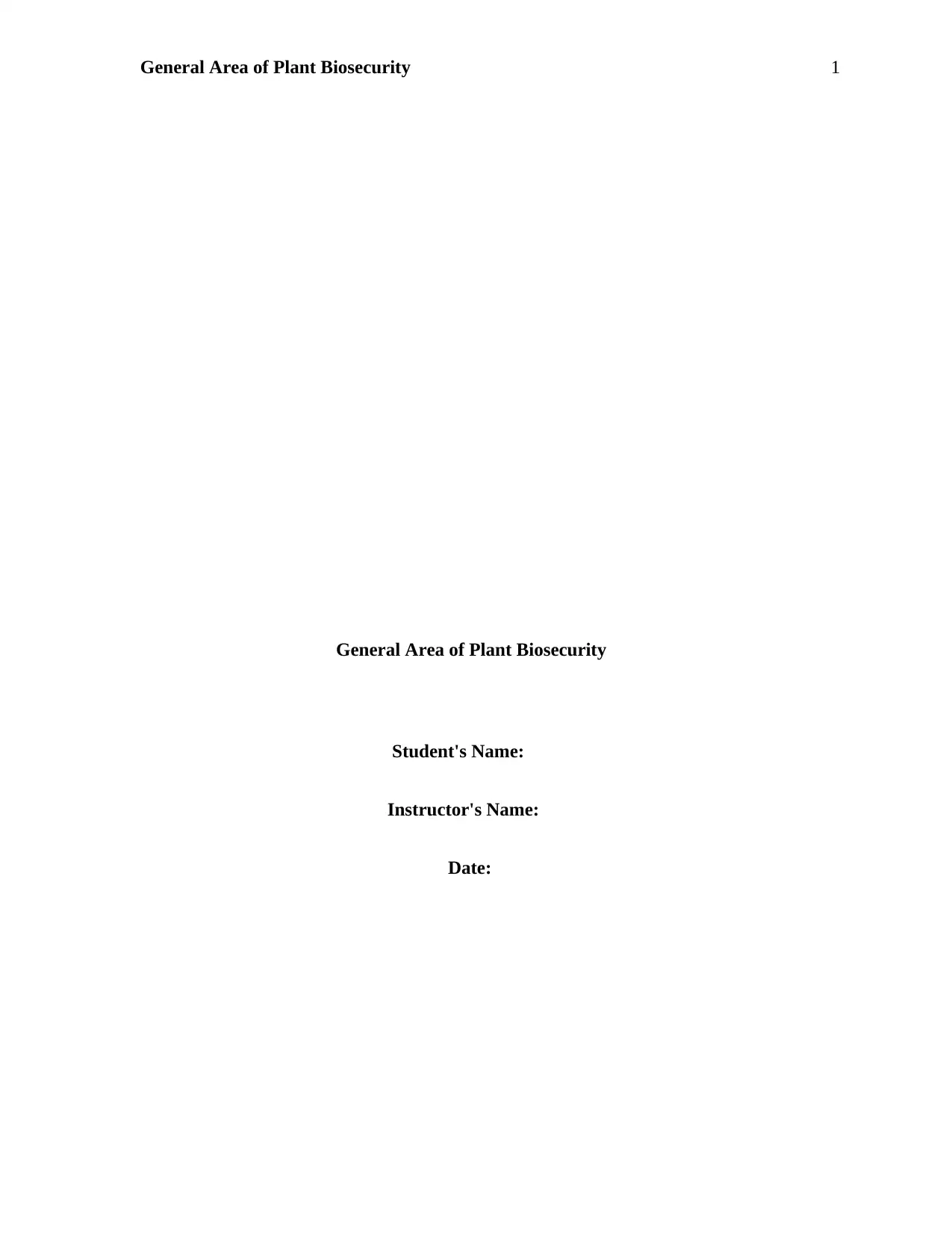
General Area of Plant Biosecurity 1
General Area of Plant Biosecurity
Student's Name:
Instructor's Name:
Date:
General Area of Plant Biosecurity
Student's Name:
Instructor's Name:
Date:
Paraphrase This Document
Need a fresh take? Get an instant paraphrase of this document with our AI Paraphraser

General Area of Plant Biosecurity 2
General Area of Plant Biosecurity
Introduction
Australia is described often as an island continent. It is for this reason that Australia is relatively
free of weeds, pests, insects, and pathogens that interfere with crop growth in other countries as
well as their exports. Australian produce is very well accepted as exports and this has lowered
the costs of production. Also, Australian being an island country is sequestered and isolated,
leading to the evolution of rich flora that are unique to the continent. This rich flora is attracting
international attention (School of Environmental and Rural Science).
With globalization, there has been an increased threat to humans, plants (Australian Department
of Agriculture, Fisheries and Forestry, 2007a), agriculture and livestock, animals (Australian
Department of Agriculture, Fisheries and Forestry, 2007b), and natural ecosystems. This is due
to the increased imports of produce from other countries. The Plant Biosecurity Cooperative
Research Centre (PBCRC), in 2012, was created for the purpose of biosecurity in Australia.
According to the PBCRC, its mission “is to develop and deploy scientific knowledge, tools,
resources and capacity to safeguard Australia, its plant industries and regional communities from
the economic, environmental and social consequences of damaging invasive plant pests and
diseases.”
Research programs are conducted to identify emerging and new threats and effective responses
and detection measures to be implemented, which include monitoring and surveillance,
safeguarding of markets and trade in Australia, and, finally, securing the future by developing
policies regarding biosecurity in Australia.
General Area of Plant Biosecurity
Introduction
Australia is described often as an island continent. It is for this reason that Australia is relatively
free of weeds, pests, insects, and pathogens that interfere with crop growth in other countries as
well as their exports. Australian produce is very well accepted as exports and this has lowered
the costs of production. Also, Australian being an island country is sequestered and isolated,
leading to the evolution of rich flora that are unique to the continent. This rich flora is attracting
international attention (School of Environmental and Rural Science).
With globalization, there has been an increased threat to humans, plants (Australian Department
of Agriculture, Fisheries and Forestry, 2007a), agriculture and livestock, animals (Australian
Department of Agriculture, Fisheries and Forestry, 2007b), and natural ecosystems. This is due
to the increased imports of produce from other countries. The Plant Biosecurity Cooperative
Research Centre (PBCRC), in 2012, was created for the purpose of biosecurity in Australia.
According to the PBCRC, its mission “is to develop and deploy scientific knowledge, tools,
resources and capacity to safeguard Australia, its plant industries and regional communities from
the economic, environmental and social consequences of damaging invasive plant pests and
diseases.”
Research programs are conducted to identify emerging and new threats and effective responses
and detection measures to be implemented, which include monitoring and surveillance,
safeguarding of markets and trade in Australia, and, finally, securing the future by developing
policies regarding biosecurity in Australia.
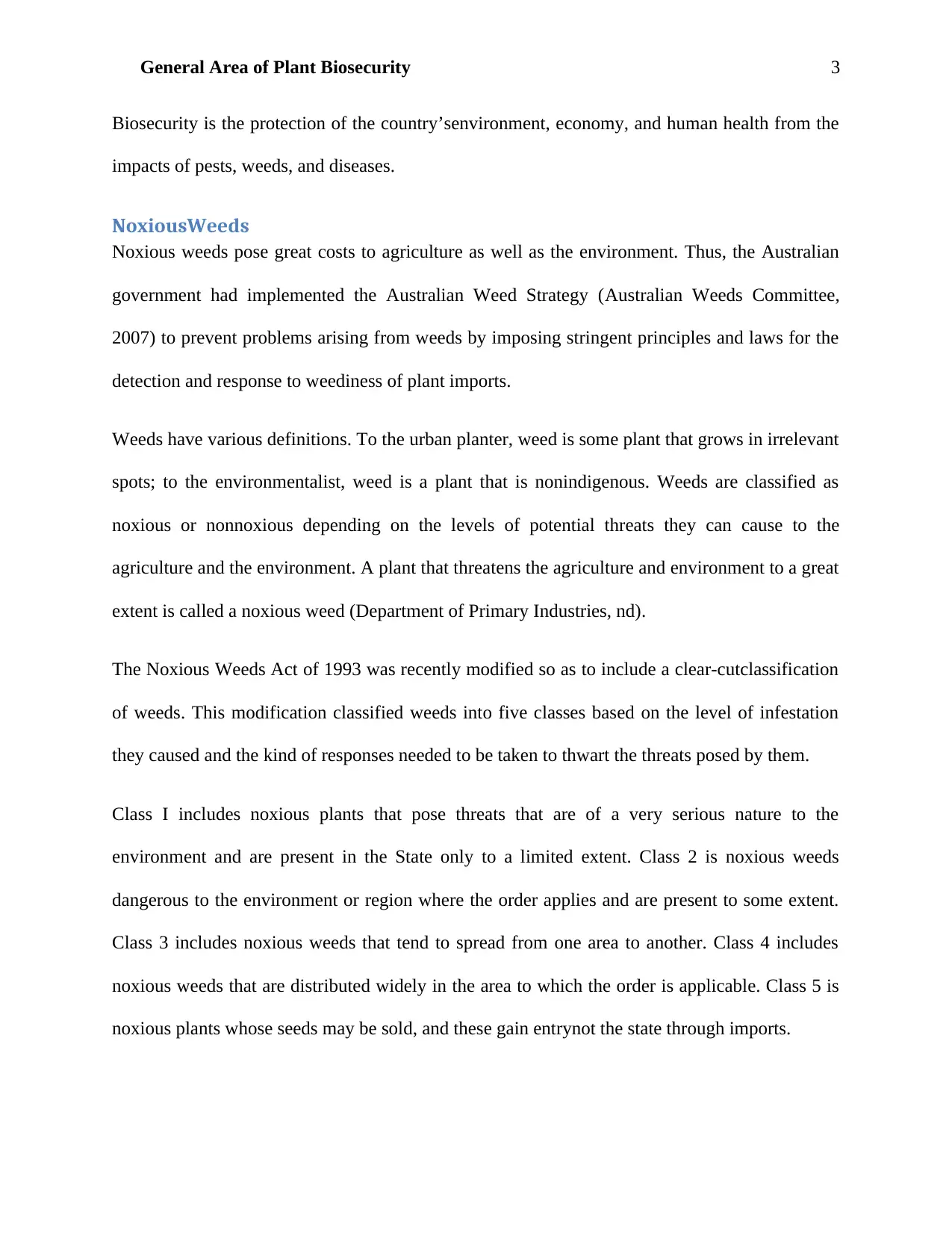
General Area of Plant Biosecurity 3
Biosecurity is the protection of the country’senvironment, economy, and human health from the
impacts of pests, weeds, and diseases.
NoxiousWeeds
Noxious weeds pose great costs to agriculture as well as the environment. Thus, the Australian
government had implemented the Australian Weed Strategy (Australian Weeds Committee,
2007) to prevent problems arising from weeds by imposing stringent principles and laws for the
detection and response to weediness of plant imports.
Weeds have various definitions. To the urban planter, weed is some plant that grows in irrelevant
spots; to the environmentalist, weed is a plant that is nonindigenous. Weeds are classified as
noxious or nonnoxious depending on the levels of potential threats they can cause to the
agriculture and the environment. A plant that threatens the agriculture and environment to a great
extent is called a noxious weed (Department of Primary Industries, nd).
The Noxious Weeds Act of 1993 was recently modified so as to include a clear-cutclassification
of weeds. This modification classified weeds into five classes based on the level of infestation
they caused and the kind of responses needed to be taken to thwart the threats posed by them.
Class I includes noxious plants that pose threats that are of a very serious nature to the
environment and are present in the State only to a limited extent. Class 2 is noxious weeds
dangerous to the environment or region where the order applies and are present to some extent.
Class 3 includes noxious weeds that tend to spread from one area to another. Class 4 includes
noxious weeds that are distributed widely in the area to which the order is applicable. Class 5 is
noxious plants whose seeds may be sold, and these gain entrynot the state through imports.
Biosecurity is the protection of the country’senvironment, economy, and human health from the
impacts of pests, weeds, and diseases.
NoxiousWeeds
Noxious weeds pose great costs to agriculture as well as the environment. Thus, the Australian
government had implemented the Australian Weed Strategy (Australian Weeds Committee,
2007) to prevent problems arising from weeds by imposing stringent principles and laws for the
detection and response to weediness of plant imports.
Weeds have various definitions. To the urban planter, weed is some plant that grows in irrelevant
spots; to the environmentalist, weed is a plant that is nonindigenous. Weeds are classified as
noxious or nonnoxious depending on the levels of potential threats they can cause to the
agriculture and the environment. A plant that threatens the agriculture and environment to a great
extent is called a noxious weed (Department of Primary Industries, nd).
The Noxious Weeds Act of 1993 was recently modified so as to include a clear-cutclassification
of weeds. This modification classified weeds into five classes based on the level of infestation
they caused and the kind of responses needed to be taken to thwart the threats posed by them.
Class I includes noxious plants that pose threats that are of a very serious nature to the
environment and are present in the State only to a limited extent. Class 2 is noxious weeds
dangerous to the environment or region where the order applies and are present to some extent.
Class 3 includes noxious weeds that tend to spread from one area to another. Class 4 includes
noxious weeds that are distributed widely in the area to which the order is applicable. Class 5 is
noxious plants whose seeds may be sold, and these gain entrynot the state through imports.
⊘ This is a preview!⊘
Do you want full access?
Subscribe today to unlock all pages.

Trusted by 1+ million students worldwide
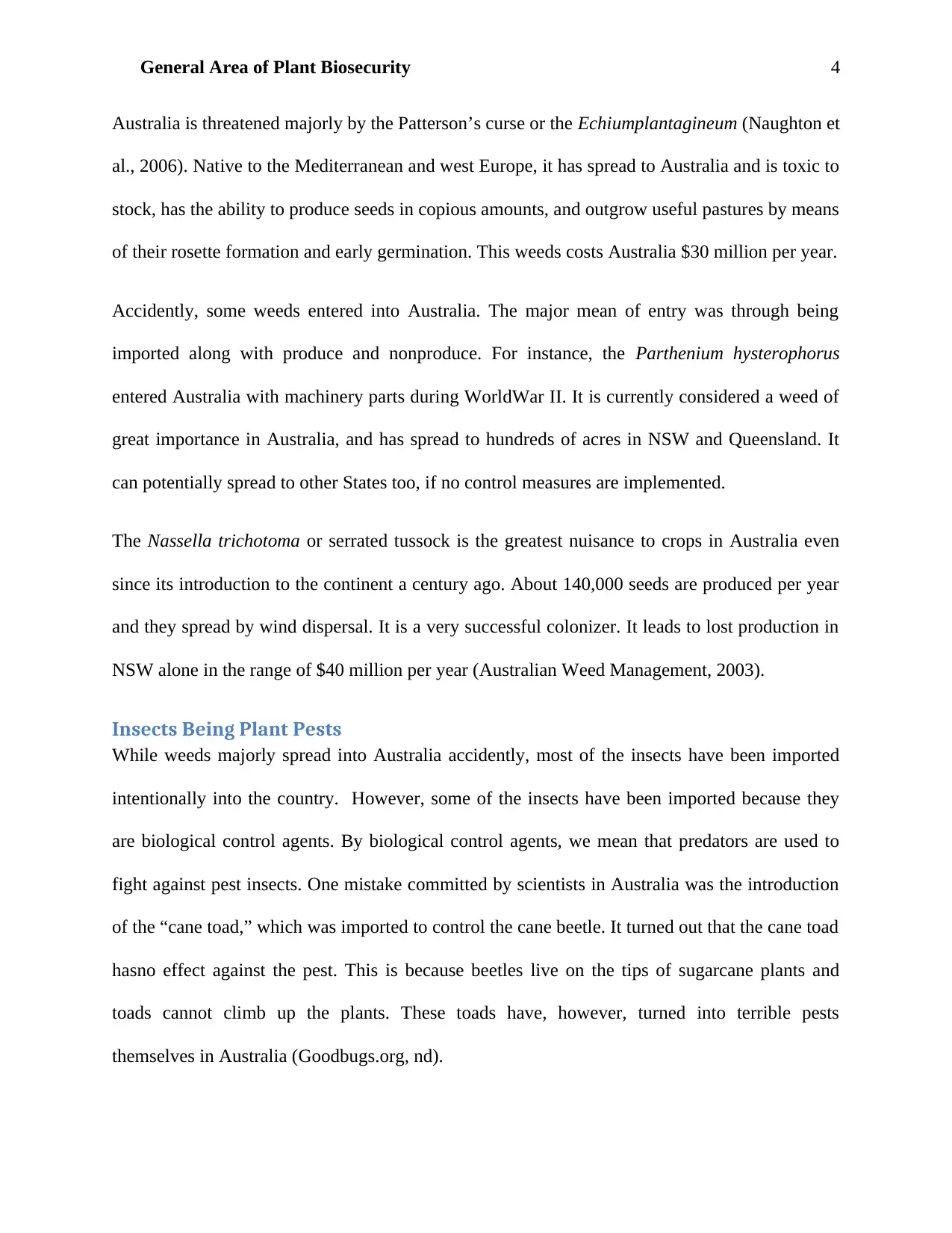
General Area of Plant Biosecurity 4
Australia is threatened majorly by the Patterson’s curse or the Echiumplantagineum (Naughton et
al., 2006). Native to the Mediterranean and west Europe, it has spread to Australia and is toxic to
stock, has the ability to produce seeds in copious amounts, and outgrow useful pastures by means
of their rosette formation and early germination. This weeds costs Australia $30 million per year.
Accidently, some weeds entered into Australia. The major mean of entry was through being
imported along with produce and nonproduce. For instance, the Parthenium hysterophorus
entered Australia with machinery parts during WorldWar II. It is currently considered a weed of
great importance in Australia, and has spread to hundreds of acres in NSW and Queensland. It
can potentially spread to other States too, if no control measures are implemented.
The Nassella trichotoma or serrated tussock is the greatest nuisance to crops in Australia even
since its introduction to the continent a century ago. About 140,000 seeds are produced per year
and they spread by wind dispersal. It is a very successful colonizer. It leads to lost production in
NSW alone in the range of $40 million per year (Australian Weed Management, 2003).
Insects Being Plant Pests
While weeds majorly spread into Australia accidently, most of the insects have been imported
intentionally into the country. However, some of the insects have been imported because they
are biological control agents. By biological control agents, we mean that predators are used to
fight against pest insects. One mistake committed by scientists in Australia was the introduction
of the “cane toad,” which was imported to control the cane beetle. It turned out that the cane toad
hasno effect against the pest. This is because beetles live on the tips of sugarcane plants and
toads cannot climb up the plants. These toads have, however, turned into terrible pests
themselves in Australia (Goodbugs.org, nd).
Australia is threatened majorly by the Patterson’s curse or the Echiumplantagineum (Naughton et
al., 2006). Native to the Mediterranean and west Europe, it has spread to Australia and is toxic to
stock, has the ability to produce seeds in copious amounts, and outgrow useful pastures by means
of their rosette formation and early germination. This weeds costs Australia $30 million per year.
Accidently, some weeds entered into Australia. The major mean of entry was through being
imported along with produce and nonproduce. For instance, the Parthenium hysterophorus
entered Australia with machinery parts during WorldWar II. It is currently considered a weed of
great importance in Australia, and has spread to hundreds of acres in NSW and Queensland. It
can potentially spread to other States too, if no control measures are implemented.
The Nassella trichotoma or serrated tussock is the greatest nuisance to crops in Australia even
since its introduction to the continent a century ago. About 140,000 seeds are produced per year
and they spread by wind dispersal. It is a very successful colonizer. It leads to lost production in
NSW alone in the range of $40 million per year (Australian Weed Management, 2003).
Insects Being Plant Pests
While weeds majorly spread into Australia accidently, most of the insects have been imported
intentionally into the country. However, some of the insects have been imported because they
are biological control agents. By biological control agents, we mean that predators are used to
fight against pest insects. One mistake committed by scientists in Australia was the introduction
of the “cane toad,” which was imported to control the cane beetle. It turned out that the cane toad
hasno effect against the pest. This is because beetles live on the tips of sugarcane plants and
toads cannot climb up the plants. These toads have, however, turned into terrible pests
themselves in Australia (Goodbugs.org, nd).
Paraphrase This Document
Need a fresh take? Get an instant paraphrase of this document with our AI Paraphraser
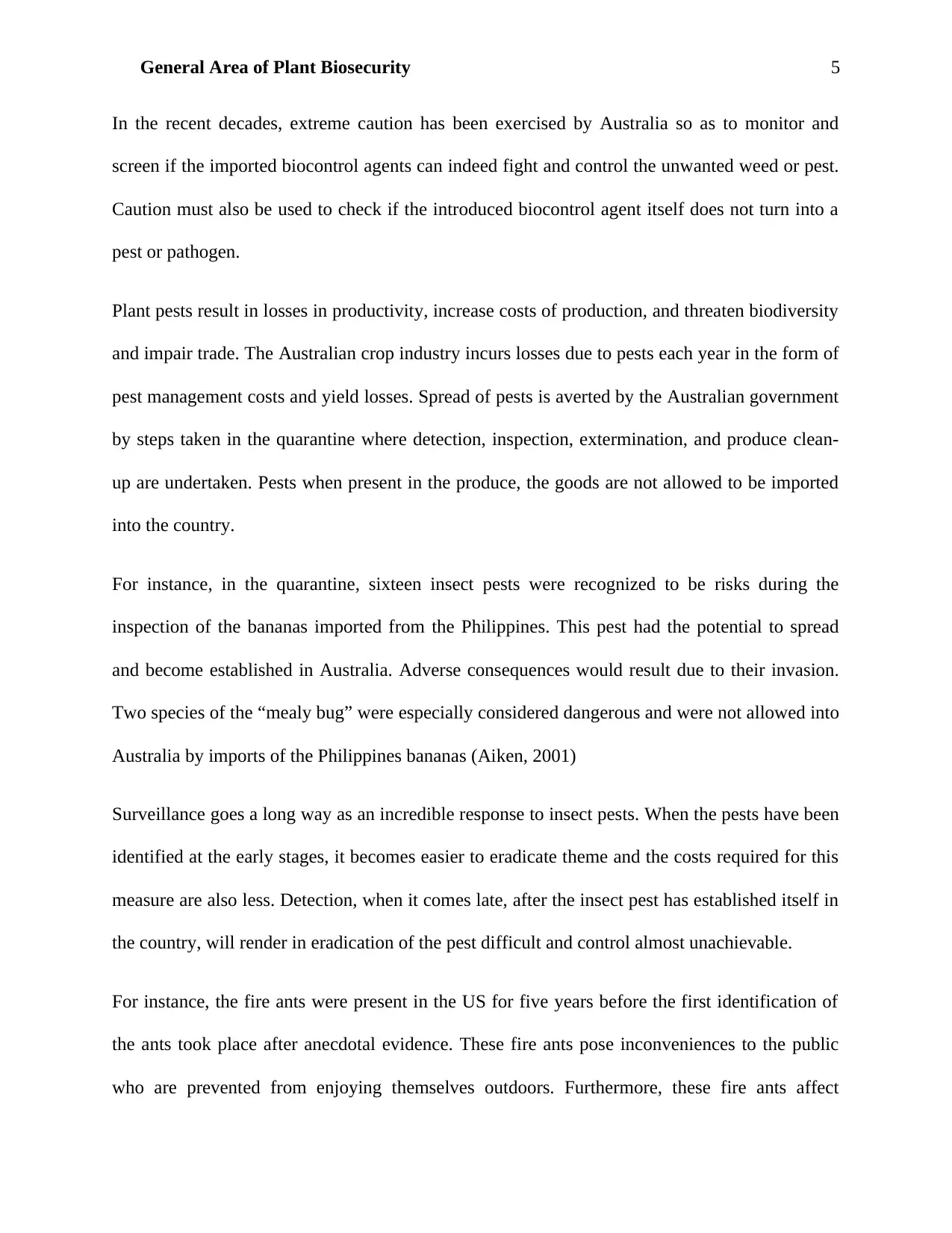
General Area of Plant Biosecurity 5
In the recent decades, extreme caution has been exercised by Australia so as to monitor and
screen if the imported biocontrol agents can indeed fight and control the unwanted weed or pest.
Caution must also be used to check if the introduced biocontrol agent itself does not turn into a
pest or pathogen.
Plant pests result in losses in productivity, increase costs of production, and threaten biodiversity
and impair trade. The Australian crop industry incurs losses due to pests each year in the form of
pest management costs and yield losses. Spread of pests is averted by the Australian government
by steps taken in the quarantine where detection, inspection, extermination, and produce clean-
up are undertaken. Pests when present in the produce, the goods are not allowed to be imported
into the country.
For instance, in the quarantine, sixteen insect pests were recognized to be risks during the
inspection of the bananas imported from the Philippines. This pest had the potential to spread
and become established in Australia. Adverse consequences would result due to their invasion.
Two species of the “mealy bug” were especially considered dangerous and were not allowed into
Australia by imports of the Philippines bananas (Aiken, 2001)
Surveillance goes a long way as an incredible response to insect pests. When the pests have been
identified at the early stages, it becomes easier to eradicate theme and the costs required for this
measure are also less. Detection, when it comes late, after the insect pest has established itself in
the country, will render in eradication of the pest difficult and control almost unachievable.
For instance, the fire ants were present in the US for five years before the first identification of
the ants took place after anecdotal evidence. These fire ants pose inconveniences to the public
who are prevented from enjoying themselves outdoors. Furthermore, these fire ants affect
In the recent decades, extreme caution has been exercised by Australia so as to monitor and
screen if the imported biocontrol agents can indeed fight and control the unwanted weed or pest.
Caution must also be used to check if the introduced biocontrol agent itself does not turn into a
pest or pathogen.
Plant pests result in losses in productivity, increase costs of production, and threaten biodiversity
and impair trade. The Australian crop industry incurs losses due to pests each year in the form of
pest management costs and yield losses. Spread of pests is averted by the Australian government
by steps taken in the quarantine where detection, inspection, extermination, and produce clean-
up are undertaken. Pests when present in the produce, the goods are not allowed to be imported
into the country.
For instance, in the quarantine, sixteen insect pests were recognized to be risks during the
inspection of the bananas imported from the Philippines. This pest had the potential to spread
and become established in Australia. Adverse consequences would result due to their invasion.
Two species of the “mealy bug” were especially considered dangerous and were not allowed into
Australia by imports of the Philippines bananas (Aiken, 2001)
Surveillance goes a long way as an incredible response to insect pests. When the pests have been
identified at the early stages, it becomes easier to eradicate theme and the costs required for this
measure are also less. Detection, when it comes late, after the insect pest has established itself in
the country, will render in eradication of the pest difficult and control almost unachievable.
For instance, the fire ants were present in the US for five years before the first identification of
the ants took place after anecdotal evidence. These fire ants pose inconveniences to the public
who are prevented from enjoying themselves outdoors. Furthermore, these fire ants affect

General Area of Plant Biosecurity 6
produce by damaging roots and seeds. Although the fire ants as a pest in the United States have
been present only for seventy years, the costs incurred due to the damage to the crops in Texas is
of the range of $US 1.5 billion.
According to Waage and Mumford (2008), greater public interest is being diverted to the control
and prevention of new diseases and pests being introduced in agriculture. The general impression
regarding threats to biosecurity is that they are increasing manifold. The biosecurity methods
employed separately for animals and plants conventionally used to differ; however, with time,
they are beginning to converge. Resource allocation for biosecurity can be better done using bio-
modeling of the pests and threats involved.
Also, the systems that will be deployed for addressing biosecurity issues tomorrow will be
different. The authors of the paper suggest three modifications in the realm of biosecurity. They
are: integrating both plantand animal approaches to biosecurity, foster greater international
cooperation to address issues of biosecurity; and model and design strategies to combat invasion
into agroecosystems and pave way for resilience.
Accordingto the “Conversation Media Group (2016)”, as connections between various parts of
the world are emerging, the spread of invasive species is also taking place very fast. These pests
pose great threat to food security, agriculture, and our ecosystems.
Certain pests that are insects such as the Asian gypsy moth, silver leaf whitefly, and Kara beetle
have been designated as serious threats to mankind and can potentially affect agriculture and
forest industries to a great extent across the globe.
produce by damaging roots and seeds. Although the fire ants as a pest in the United States have
been present only for seventy years, the costs incurred due to the damage to the crops in Texas is
of the range of $US 1.5 billion.
According to Waage and Mumford (2008), greater public interest is being diverted to the control
and prevention of new diseases and pests being introduced in agriculture. The general impression
regarding threats to biosecurity is that they are increasing manifold. The biosecurity methods
employed separately for animals and plants conventionally used to differ; however, with time,
they are beginning to converge. Resource allocation for biosecurity can be better done using bio-
modeling of the pests and threats involved.
Also, the systems that will be deployed for addressing biosecurity issues tomorrow will be
different. The authors of the paper suggest three modifications in the realm of biosecurity. They
are: integrating both plantand animal approaches to biosecurity, foster greater international
cooperation to address issues of biosecurity; and model and design strategies to combat invasion
into agroecosystems and pave way for resilience.
Accordingto the “Conversation Media Group (2016)”, as connections between various parts of
the world are emerging, the spread of invasive species is also taking place very fast. These pests
pose great threat to food security, agriculture, and our ecosystems.
Certain pests that are insects such as the Asian gypsy moth, silver leaf whitefly, and Kara beetle
have been designated as serious threats to mankind and can potentially affect agriculture and
forest industries to a great extent across the globe.
⊘ This is a preview!⊘
Do you want full access?
Subscribe today to unlock all pages.

Trusted by 1+ million students worldwide
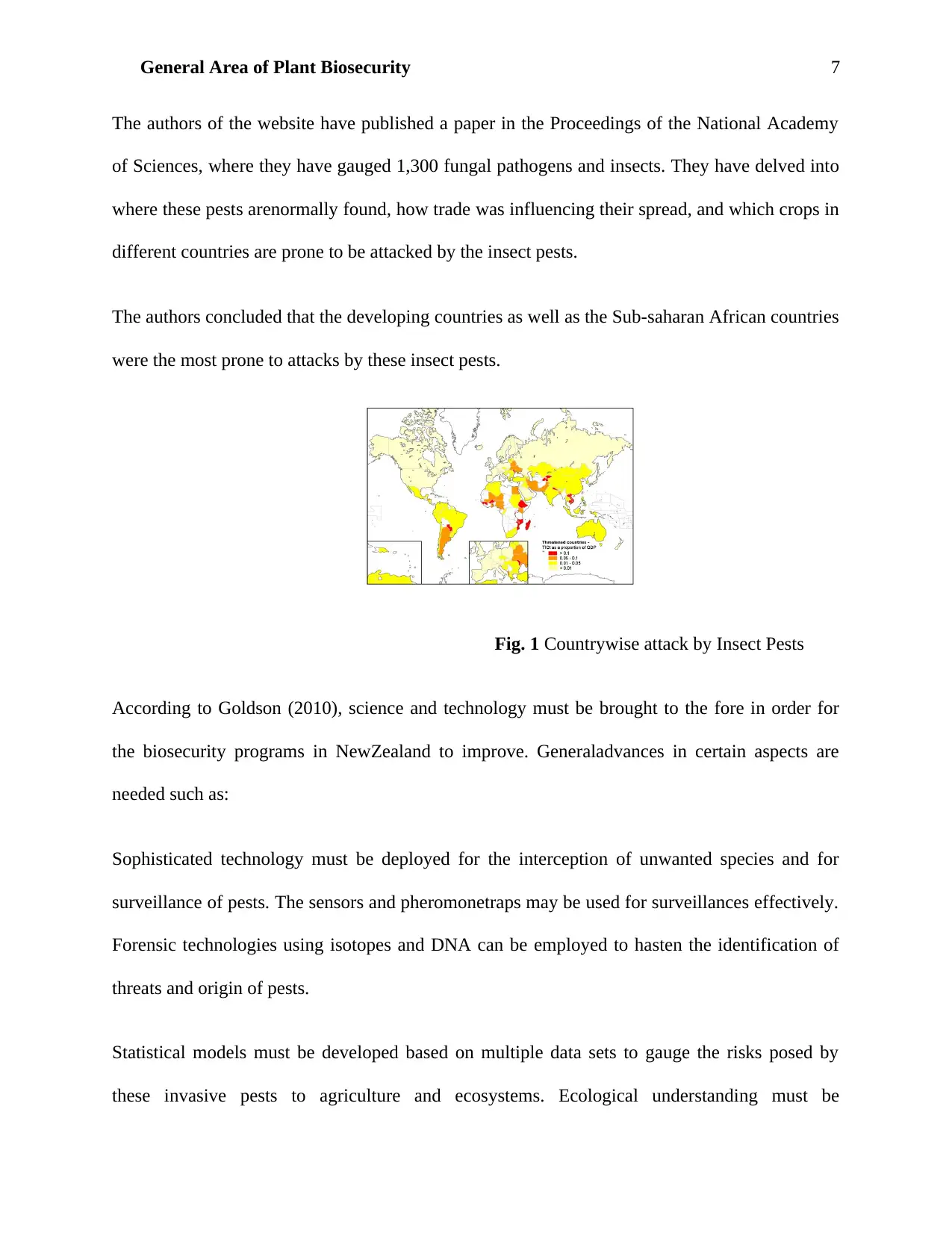
General Area of Plant Biosecurity 7
The authors of the website have published a paper in the Proceedings of the National Academy
of Sciences, where they have gauged 1,300 fungal pathogens and insects. They have delved into
where these pests arenormally found, how trade was influencing their spread, and which crops in
different countries are prone to be attacked by the insect pests.
The authors concluded that the developing countries as well as the Sub-saharan African countries
were the most prone to attacks by these insect pests.
Fig. 1 Countrywise attack by Insect Pests
According to Goldson (2010), science and technology must be brought to the fore in order for
the biosecurity programs in NewZealand to improve. Generaladvances in certain aspects are
needed such as:
Sophisticated technology must be deployed for the interception of unwanted species and for
surveillance of pests. The sensors and pheromonetraps may be used for surveillances effectively.
Forensic technologies using isotopes and DNA can be employed to hasten the identification of
threats and origin of pests.
Statistical models must be developed based on multiple data sets to gauge the risks posed by
these invasive pests to agriculture and ecosystems. Ecological understanding must be
The authors of the website have published a paper in the Proceedings of the National Academy
of Sciences, where they have gauged 1,300 fungal pathogens and insects. They have delved into
where these pests arenormally found, how trade was influencing their spread, and which crops in
different countries are prone to be attacked by the insect pests.
The authors concluded that the developing countries as well as the Sub-saharan African countries
were the most prone to attacks by these insect pests.
Fig. 1 Countrywise attack by Insect Pests
According to Goldson (2010), science and technology must be brought to the fore in order for
the biosecurity programs in NewZealand to improve. Generaladvances in certain aspects are
needed such as:
Sophisticated technology must be deployed for the interception of unwanted species and for
surveillance of pests. The sensors and pheromonetraps may be used for surveillances effectively.
Forensic technologies using isotopes and DNA can be employed to hasten the identification of
threats and origin of pests.
Statistical models must be developed based on multiple data sets to gauge the risks posed by
these invasive pests to agriculture and ecosystems. Ecological understanding must be
Paraphrase This Document
Need a fresh take? Get an instant paraphrase of this document with our AI Paraphraser

General Area of Plant Biosecurity 8
emphasized on to comprehend the nature of these pests, their effects on ecosystems and their
behaviors relevant to New Zealand.
Also, fumigation, eradication, and containing of pests methods are needed that would also be
categorized as socially acceptable and advanced.
Biosafety and Food Security
In Australia, the confidence on the quality and safety of imports and domestic food is deemed a
high priority and as essential. When impure, unsafe, and poor-quality food is traded, then the
threats posed to mankind, agriculture, and ecosystem of a country is very high. Therefore,
legislation is warranted to be imposed to protect the country and its inhabitant from the invasion
of pests. There are two acts that caterto these requests. They are the Imported Food Control Act
1992 and Food Standards Australia and New Zealand Act 1991. These two acts safeguard food
safety in Australia. Thus, these two acts promote the quality and safety of foods in New Zealand
and Australia. Further, they go on to develop consumer confidence in the foods grown in the two
countries. The Imported Food Control, an ACT, oversees the quality of imported foods into the
countries and has provisions for genetically modified foods to be scrutinized too. These two acts
play a vital role in Australia and New Zealand, as these two countries import foods from those
regions that are less advanced technically.
Food security not only concerns itself with food safetyand quality; it ensures the supply of safe,
adequate, and nutritious food to the citizens of a country. Australia is an affluent nation, and is a
second-world country and has enough foodsecurity for its citizens with only few going hungry at
times. A reliable supply of food is generally disrupted by political unrest, poverty, natural
disasters, droughts, fires, and floods, diseases of crops, and unemployment. Australia, as an
emphasized on to comprehend the nature of these pests, their effects on ecosystems and their
behaviors relevant to New Zealand.
Also, fumigation, eradication, and containing of pests methods are needed that would also be
categorized as socially acceptable and advanced.
Biosafety and Food Security
In Australia, the confidence on the quality and safety of imports and domestic food is deemed a
high priority and as essential. When impure, unsafe, and poor-quality food is traded, then the
threats posed to mankind, agriculture, and ecosystem of a country is very high. Therefore,
legislation is warranted to be imposed to protect the country and its inhabitant from the invasion
of pests. There are two acts that caterto these requests. They are the Imported Food Control Act
1992 and Food Standards Australia and New Zealand Act 1991. These two acts safeguard food
safety in Australia. Thus, these two acts promote the quality and safety of foods in New Zealand
and Australia. Further, they go on to develop consumer confidence in the foods grown in the two
countries. The Imported Food Control, an ACT, oversees the quality of imported foods into the
countries and has provisions for genetically modified foods to be scrutinized too. These two acts
play a vital role in Australia and New Zealand, as these two countries import foods from those
regions that are less advanced technically.
Food security not only concerns itself with food safetyand quality; it ensures the supply of safe,
adequate, and nutritious food to the citizens of a country. Australia is an affluent nation, and is a
second-world country and has enough foodsecurity for its citizens with only few going hungry at
times. A reliable supply of food is generally disrupted by political unrest, poverty, natural
disasters, droughts, fires, and floods, diseases of crops, and unemployment. Australia, as an
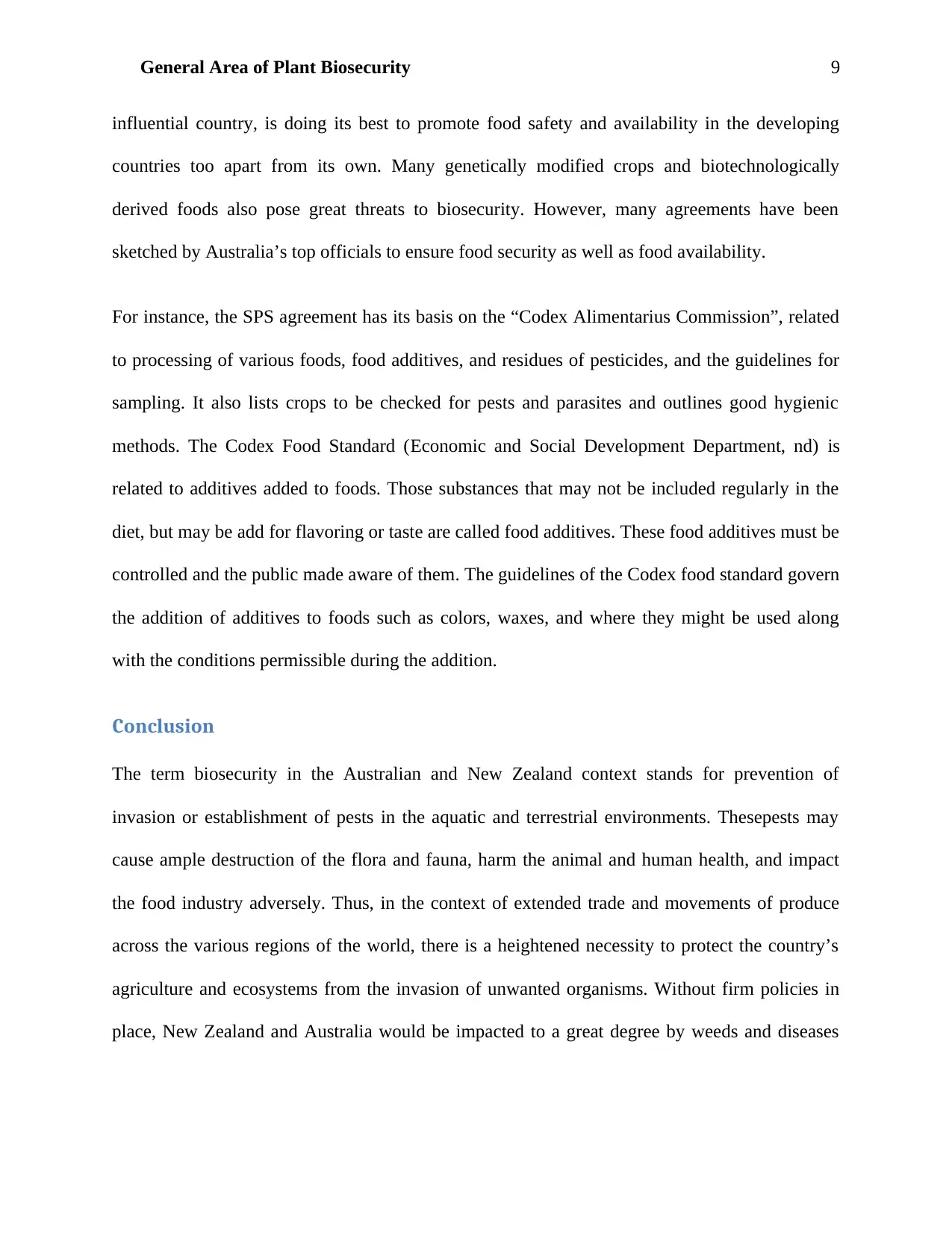
General Area of Plant Biosecurity 9
influential country, is doing its best to promote food safety and availability in the developing
countries too apart from its own. Many genetically modified crops and biotechnologically
derived foods also pose great threats to biosecurity. However, many agreements have been
sketched by Australia’s top officials to ensure food security as well as food availability.
For instance, the SPS agreement has its basis on the “Codex Alimentarius Commission”, related
to processing of various foods, food additives, and residues of pesticides, and the guidelines for
sampling. It also lists crops to be checked for pests and parasites and outlines good hygienic
methods. The Codex Food Standard (Economic and Social Development Department, nd) is
related to additives added to foods. Those substances that may not be included regularly in the
diet, but may be add for flavoring or taste are called food additives. These food additives must be
controlled and the public made aware of them. The guidelines of the Codex food standard govern
the addition of additives to foods such as colors, waxes, and where they might be used along
with the conditions permissible during the addition.
Conclusion
The term biosecurity in the Australian and New Zealand context stands for prevention of
invasion or establishment of pests in the aquatic and terrestrial environments. Thesepests may
cause ample destruction of the flora and fauna, harm the animal and human health, and impact
the food industry adversely. Thus, in the context of extended trade and movements of produce
across the various regions of the world, there is a heightened necessity to protect the country’s
agriculture and ecosystems from the invasion of unwanted organisms. Without firm policies in
place, New Zealand and Australia would be impacted to a great degree by weeds and diseases
influential country, is doing its best to promote food safety and availability in the developing
countries too apart from its own. Many genetically modified crops and biotechnologically
derived foods also pose great threats to biosecurity. However, many agreements have been
sketched by Australia’s top officials to ensure food security as well as food availability.
For instance, the SPS agreement has its basis on the “Codex Alimentarius Commission”, related
to processing of various foods, food additives, and residues of pesticides, and the guidelines for
sampling. It also lists crops to be checked for pests and parasites and outlines good hygienic
methods. The Codex Food Standard (Economic and Social Development Department, nd) is
related to additives added to foods. Those substances that may not be included regularly in the
diet, but may be add for flavoring or taste are called food additives. These food additives must be
controlled and the public made aware of them. The guidelines of the Codex food standard govern
the addition of additives to foods such as colors, waxes, and where they might be used along
with the conditions permissible during the addition.
Conclusion
The term biosecurity in the Australian and New Zealand context stands for prevention of
invasion or establishment of pests in the aquatic and terrestrial environments. Thesepests may
cause ample destruction of the flora and fauna, harm the animal and human health, and impact
the food industry adversely. Thus, in the context of extended trade and movements of produce
across the various regions of the world, there is a heightened necessity to protect the country’s
agriculture and ecosystems from the invasion of unwanted organisms. Without firm policies in
place, New Zealand and Australia would be impacted to a great degree by weeds and diseases
⊘ This is a preview!⊘
Do you want full access?
Subscribe today to unlock all pages.

Trusted by 1+ million students worldwide

General Area of Plant Biosecurity 10
and pests, and productivity and biodiversity would be hampered. Serious public health
implications are possible when laws are not enforced to contain the pests from invading.
Biosecurity encompasses efforts to first “contain” the treats by coordinated efforts and then
completely try to eradicate the threat (Thomson, 1991). When eradication is not possible, the at
least “fine control”of the invasion must be exerted.
While the term biosecurity has different meanings in NewZealand and Australia, it means
differently in North America and Europe. In these latter countries, the term means prevention of
misuse of biotechnology methods for purposes of terrorism such as the incidence of attack of
anthrax in the US in 2001 (Meyerson and Reaser, 2002).
Challenges Ahead
Despite the strides made in the sphere of biosecurity, huge challenges are possibly threatening
New Zealand bioecosystems. For instance, the measures to be undertaken in the light of huge
numbers of passengers and freight streaming into New Zealand are still ambiguously laid down.
We have reached a situation where progress can be made only if recent and advanced technology
is made use of to contain the invasion of pests and unwanted organismsin the territory.
Coordination, cooperation, and partnerships arethe true essences of the efforts needed to be taken
up by regions that want to protect their health and agriculture. More research is warranted in the
sphere of biosecurity and the challenges must be comprehended well enough for suitable policies
to beframed and implemented (Goldson, 2010).
and pests, and productivity and biodiversity would be hampered. Serious public health
implications are possible when laws are not enforced to contain the pests from invading.
Biosecurity encompasses efforts to first “contain” the treats by coordinated efforts and then
completely try to eradicate the threat (Thomson, 1991). When eradication is not possible, the at
least “fine control”of the invasion must be exerted.
While the term biosecurity has different meanings in NewZealand and Australia, it means
differently in North America and Europe. In these latter countries, the term means prevention of
misuse of biotechnology methods for purposes of terrorism such as the incidence of attack of
anthrax in the US in 2001 (Meyerson and Reaser, 2002).
Challenges Ahead
Despite the strides made in the sphere of biosecurity, huge challenges are possibly threatening
New Zealand bioecosystems. For instance, the measures to be undertaken in the light of huge
numbers of passengers and freight streaming into New Zealand are still ambiguously laid down.
We have reached a situation where progress can be made only if recent and advanced technology
is made use of to contain the invasion of pests and unwanted organismsin the territory.
Coordination, cooperation, and partnerships arethe true essences of the efforts needed to be taken
up by regions that want to protect their health and agriculture. More research is warranted in the
sphere of biosecurity and the challenges must be comprehended well enough for suitable policies
to beframed and implemented (Goldson, 2010).
Paraphrase This Document
Need a fresh take? Get an instant paraphrase of this document with our AI Paraphraser
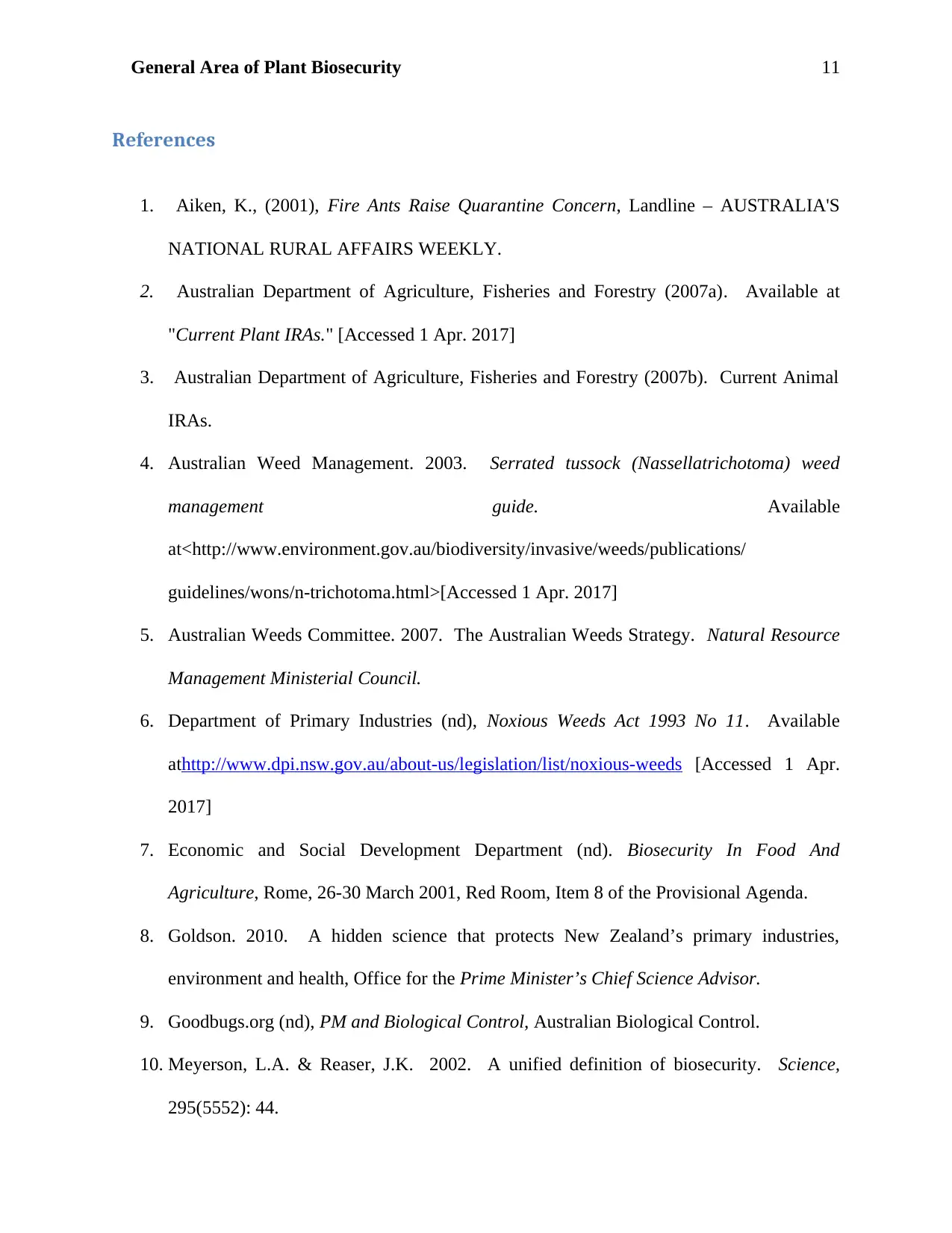
General Area of Plant Biosecurity 11
References
1. Aiken, K., (2001), Fire Ants Raise Quarantine Concern, Landline – AUSTRALIA'S
NATIONAL RURAL AFFAIRS WEEKLY.
2. Australian Department of Agriculture, Fisheries and Forestry (2007a). Available at
"Current Plant IRAs." [Accessed 1 Apr. 2017]
3. Australian Department of Agriculture, Fisheries and Forestry (2007b). Current Animal
IRAs.
4. Australian Weed Management. 2003. Serrated tussock (Nassellatrichotoma) weed
management guide. Available
at<http://www.environment.gov.au/biodiversity/invasive/weeds/publications/
guidelines/wons/n-trichotoma.html>[Accessed 1 Apr. 2017]
5. Australian Weeds Committee. 2007. The Australian Weeds Strategy. Natural Resource
Management Ministerial Council.
6. Department of Primary Industries (nd), Noxious Weeds Act 1993 No 11. Available
athttp://www.dpi.nsw.gov.au/about-us/legislation/list/noxious-weeds [Accessed 1 Apr.
2017]
7. Economic and Social Development Department (nd). Biosecurity In Food And
Agriculture, Rome, 26-30 March 2001, Red Room, Item 8 of the Provisional Agenda.
8. Goldson. 2010. A hidden science that protects New Zealand’s primary industries,
environment and health, Office for the Prime Minister’s Chief Science Advisor.
9. Goodbugs.org (nd), PM and Biological Control, Australian Biological Control.
10. Meyerson, L.A. & Reaser, J.K. 2002. A unified definition of biosecurity. Science,
295(5552): 44.
References
1. Aiken, K., (2001), Fire Ants Raise Quarantine Concern, Landline – AUSTRALIA'S
NATIONAL RURAL AFFAIRS WEEKLY.
2. Australian Department of Agriculture, Fisheries and Forestry (2007a). Available at
"Current Plant IRAs." [Accessed 1 Apr. 2017]
3. Australian Department of Agriculture, Fisheries and Forestry (2007b). Current Animal
IRAs.
4. Australian Weed Management. 2003. Serrated tussock (Nassellatrichotoma) weed
management guide. Available
at<http://www.environment.gov.au/biodiversity/invasive/weeds/publications/
guidelines/wons/n-trichotoma.html>[Accessed 1 Apr. 2017]
5. Australian Weeds Committee. 2007. The Australian Weeds Strategy. Natural Resource
Management Ministerial Council.
6. Department of Primary Industries (nd), Noxious Weeds Act 1993 No 11. Available
athttp://www.dpi.nsw.gov.au/about-us/legislation/list/noxious-weeds [Accessed 1 Apr.
2017]
7. Economic and Social Development Department (nd). Biosecurity In Food And
Agriculture, Rome, 26-30 March 2001, Red Room, Item 8 of the Provisional Agenda.
8. Goldson. 2010. A hidden science that protects New Zealand’s primary industries,
environment and health, Office for the Prime Minister’s Chief Science Advisor.
9. Goodbugs.org (nd), PM and Biological Control, Australian Biological Control.
10. Meyerson, L.A. & Reaser, J.K. 2002. A unified definition of biosecurity. Science,
295(5552): 44.

General Area of Plant Biosecurity 12
11. Naughton et al. 2006. Paterson’s Curse, NSW Department of Primary Industries,
Available at<http://www.dpi.nsw.gov.au/__data/assets/pdf_file/0011/88490/patersons-
curse.pdf>[Accessed 1 Apr. 2017]
12. School of Environmental and Rural Science (nd). Introduction to Plant Biosecurity. The
University of New England.
13. The Conversation. 2016. Global Agriculture Study Finds Developing Countries Most
Threatened By Invasive Pest Species. Available at<http://theconversation.com/global-
agriculture-study-finds-developing-countries-most-threatened-by-invasive-pest-species-
61280>[Accessed 1 Apr. 2017].
14. Thomson, J. 1991. Biosecurity: preventing and controlling diseases in the beef herd.
Livestock Conservation Institute, 49-51.
15. Waage & Mumford. 2008. Agricultural Biosecurity. Philos Trans R SocLond B Biol Sci,
363, pp. 863–876.
11. Naughton et al. 2006. Paterson’s Curse, NSW Department of Primary Industries,
Available at<http://www.dpi.nsw.gov.au/__data/assets/pdf_file/0011/88490/patersons-
curse.pdf>[Accessed 1 Apr. 2017]
12. School of Environmental and Rural Science (nd). Introduction to Plant Biosecurity. The
University of New England.
13. The Conversation. 2016. Global Agriculture Study Finds Developing Countries Most
Threatened By Invasive Pest Species. Available at<http://theconversation.com/global-
agriculture-study-finds-developing-countries-most-threatened-by-invasive-pest-species-
61280>[Accessed 1 Apr. 2017].
14. Thomson, J. 1991. Biosecurity: preventing and controlling diseases in the beef herd.
Livestock Conservation Institute, 49-51.
15. Waage & Mumford. 2008. Agricultural Biosecurity. Philos Trans R SocLond B Biol Sci,
363, pp. 863–876.
⊘ This is a preview!⊘
Do you want full access?
Subscribe today to unlock all pages.

Trusted by 1+ million students worldwide
1 out of 12
Your All-in-One AI-Powered Toolkit for Academic Success.
+13062052269
info@desklib.com
Available 24*7 on WhatsApp / Email
![[object Object]](/_next/static/media/star-bottom.7253800d.svg)
Unlock your academic potential
Copyright © 2020–2025 A2Z Services. All Rights Reserved. Developed and managed by ZUCOL.